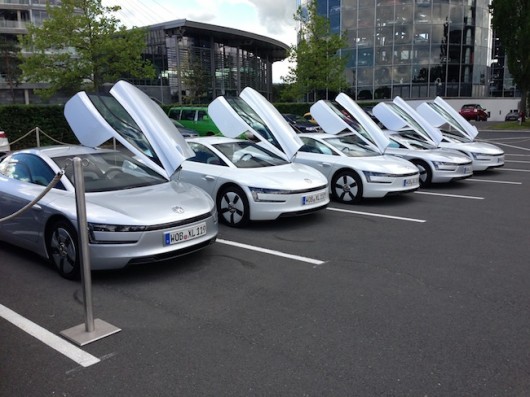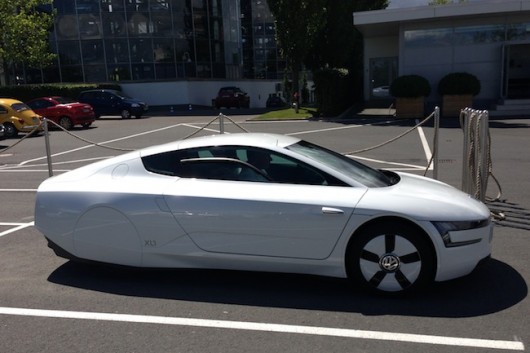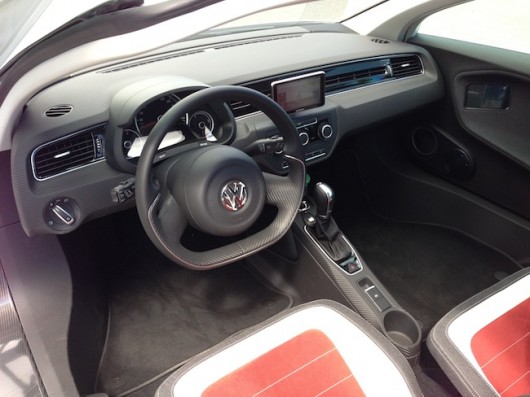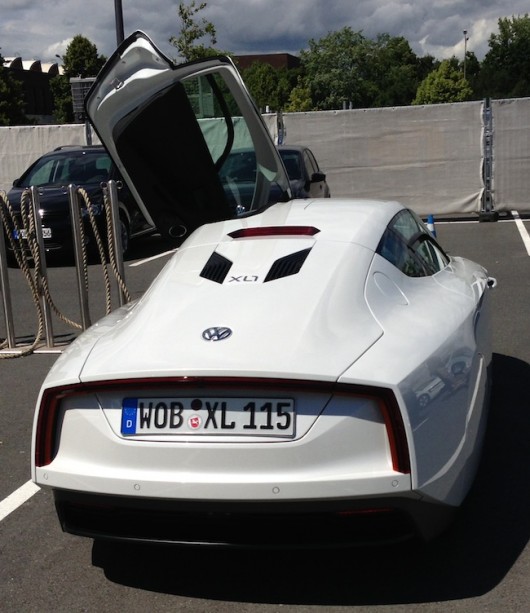Volkswagen XL1 – Most Fuel Efficient Car – 261mpg!
- June 27, 2013
- New Model Introductions, On The Road: Driving Impressions, Technology & New Features, Volkswagen
- Posted by George Peterson
- Comments Off on Volkswagen XL1 – Most Fuel Efficient Car – 261mpg!
About 20 American journalists and analysts had a chance to drive the Volkswagen XL1 at the Autostadt near Volkswagen headquarters in Wolfsburg, Germany. Only 20 of the planned 250 vehicles have been completed to date and five were on hand for our drives. A Volkswagen engineer guided each drive through Wolfsburg and even included a short autobahn blast hitting the car’s top speed limited to 160kmh (about 99mph).
261 MPG! The XL1 is very special. First, it looks totally cool and highly aerodynamic. Volkswagen has been developing a car to achieve the European objective of 1 liter of fuel consumed per 100 kilometers driven for over a decade now. This equates to 238mpg using United States gallons. The XL1 actually beats this. It gets 0.9L/100km fuel efficiency (about 261mpg!). With its 10L (2.6-gallons) fuel tank this translates to a cruising range of over 600-miles on a tank of diesel.
How does it do this? A combination of small size, great aerodynamics (Cd=0.189), plug-in-hybrid 2-cylinder turbo-diesel powertrain and a carbon fiber body that weighs only 197lbs. To save weight, VW forgoes an on-board charger – at least for the first 50 in their production run. Adding an on-board charger (which would allow the car to be charged at a public charge station rather than a dedicated charger likely in someone’s garage) would add 8kg (about 18lbs) to the weight of the car. VW is considering adding a charger to the last 200 of the vehicles.
Staggered Seating The seating package uses a trick out of the smart fortwo design. The seat in the two passenger car are staggered with the passenger seated slightly to the rear of the driver so shoulders won’t touch. The XL1 certainly is not spacious, but for a hyper-miler it may be just the ticket. Seeing the XL1 out in traffic reinforces just how small the car has to get to achieve such great fuel consumption. It is tiny. It is about an inch lower than a Lamborghini – and those come up about to your waist. In traffic, it is dwarfed by other cars – even the small VW Polo and Lupo models driving around Wolfsburg. To its credit, and for better aerodynamics, the rear of the body is lengthened and yields a trunk of 4.2 cubic feet – about twice the size of the first generation Mazda Miata.
Advanced Powertrain The XL1 is a rear engine, rear wheel drive car. The diesel is hard-mounted just behind the passenger compartment. Given that location it is very obvious when the diesel kicks in. At least in the early models, NVH (noise, vibration and harshness) is sacrificed to achieve a total weight of 1723 pounds. The diesel is relatively noisy and with only two cylinders it vibrates quite a bit. The 5.5kw battery pack is mounted in front of the driver and on electric-only power the car will go 31 miles. XL1 uses a DSG (automatic) transmission from VW’s new MQB platform. If you really step on it, the XL1 will achieve a 0-60mph time of 12.7 seconds. With no power steering, the rear engined car is a bit heavy feeling but not objectionable.
Rear View Cameras – a Bit Uncomfortable Probably the most uncomfortable part of driving XL1 is rear visibility. VW has received an exemption from the EU to use rear view cameras instead of outside rear view mirrors. The viewing screens are mounted in the door trim panels just forward of the armrests. You have to look down left or right to see the traffic behind you. Takes a bit to get used to the design. You never really know where the traffic is in your blind spot.





